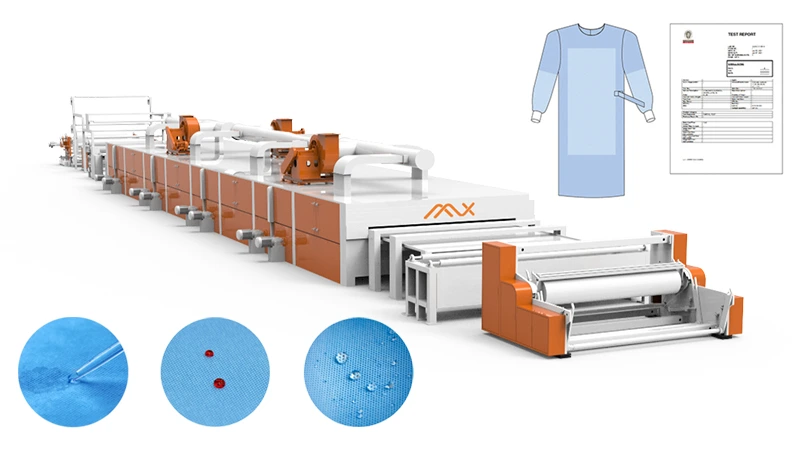
Introduction to SSMMS Nonwoven Fabric Application in Surgical Gowns
Surgical Gown Product Standards and Materials
Composite structure nonwoven fabrics (such as SMS/SMMS/SSMMS/SSMMMS) are the core materials for modern medical protective products, including surgical drapes, surgical gowns, and cleanroom garments. These multi-layer materials are typically composed of polypropylene fibers and combine the excellent strength of the Spunbond (S) layer with the outstanding filtration efficiency of the Meltblown (M) layer.
Among these, SSMMS represents a five-layer structure: a stack of three Spunbond layers (S) and two Meltblown layers (M) (S-S-M-M-S). This structure significantly enhances the material’s fine filtration, low pressure drop, good strength, and softness. The multi-layer Meltblown component gives SSMMS excellent high barrier properties against liquids and particulates, making it an ideal choice for manufacturing high-grade medical protective clothing. Furthermore, these materials are suitable for common sterilization methods, including steam, EtO (Ethylene Oxide), and low-temperature plasma.
In practical application, surgical gowns must cope with complex clinical environments, so the material must possess several key functions, including resistance to alcohol, blood, and oil, as well as anti-static properties and high barrier performance. To ensure the safety of patients and healthcare professionals, surgical gowns must meet strict international product standards, which mainly include:
As a professional nonwoven machine manufacturer, AZX has compiled this table comparing surgical gown material parameters and processing methods that meet the standards, based on years of production data and experience from various collaborating manufacturers, for nonwoven fabric producers’ reference.
| Compliance Standard | Main Material | Sewing Method |
| AAMI Level 3 | Base fabric: ARAS 50gsm SSMMS Reinforcement: SF Material | Ultrasonic Sewing, Gluing on Reinforcement |
| AAMI Level 2 | Base fabric: ARAS 35gsm SSMMS Reinforcement: SF Material | Ultrasonic Sewing, Gluing on Reinforcement |
| EN13795:2019 Standard Performance | ARAS 35/45gsm SSMMS | Ultrasonic Sewing |
| EN13795:2019 High Performance | Base fabric: ARAS 35/45gsm SSMMS Reinforcement: SF Material | Ultrasonic Sewing, Gluing on Reinforcement |
Explanation:
SSMMS Production Process and Post-Treatment Technology – Key to Surgical Gowns
An SSMMS nonwoven fabric production line integrates three steps—spinning, web forming, and web consolidation—into one continuous production line. As a professional nonwoven equipment manufacturer, AZX not only provides efficient and high-quality SSMMS production lines but also offers professional nonwoven fabric post-treatment technology and solutions to meet the stringent requirements of medical-grade protective nonwoven fabrics.
1. SSMMS Production Process
The five-layer structure of SSMMS (Spunbond-Spunbond-Meltblown-Meltblown-Spunbond) is achieved through the perfect combination of the following three core processes:
2. Nonwoven Fabric Post-Treatment Technology
High-quality SSMMS nonwoven fabric is only the basic material for surgical gowns; nonwoven fabric post-treatment technology is the key to surgical gowns meeting high standards. (Post-treatment technology is also called finish technology or after finish technology, depending on what you want to call it.)
ARAS Treatment Technology is achieved through a professional post-treatment process, imparting anti-alcohol, anti-blood, anti-oil, and anti-static functions to the nonwoven fabric. It primarily uses an offline post-treatment method for processing. The main production process is as follows: Unwinding → Padding→ Feeding → Stenter → Multi-stage Drying → Cooling → Winding/Slitting
Among these, the Padding stage requires a dedicated liquid preparation system and post-treatment agents to give the nonwoven fabric its ARAS characteristics. The schematic diagram is as follows:
SF Material is produced through a coating/lamination compounding process, where Spunbond Nonwoven and PE Film are compounded in a double-layer or multi-layer manner. This creates a composite nonwoven material with high strength, high barrier properties, and high hydrostatic pressure, mainly used for the reinforcement part of surgical gowns. The main production process is as follows: Substrate Unwinding → PE Melting Extrusion → Coating/Lamination → Cooling → Winding/Slitting
The schematic diagram is as follows:
Ultimately, a surgical gown uses SSMMS nonwoven fabric treated with ARAS Treatment Technology as the base fabric, combined with the reinforcement of SF Material, allowing it to easily meet the requirements of AAMI Level 3 and other relevant product standards.
AZX, with its extensive customer service experience, provides you with complete and reliable production solutions for medical nonwoven materials, helping you succeed in the nonwoven industry.
If you would like to know more, please contact us, and we will share it with you without reservation.
At this exhibition, AZX Group will highlight our nonwoven production line technologies. Include: SSMMSS, SSMMS,…
AZX Nonwoven Machine will participate in the Nonwoven Expo Bangladesh 2025 (July 24-26, booth 61-Hall-4).…
If you operate a nonwoven machine, you know the frustration of polymer residue accumulating on…
The structure of the suction air box significantly affects the web density and hydrostatic pressure…
Complementary Effect in the Web Forming Process In the SMS spunbond nonwoven production line, the…
Foshan AZX offers advanced meltblown nonwoven machines for producing high-performance automotive sound insulation and air…